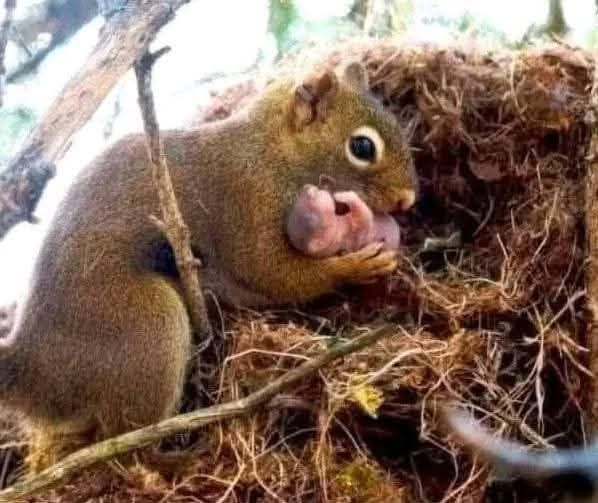When we think of nurturing and parental care, we often imagine moms of our own species caring for their offspring. But did you know that in the little harbors of the forest — nests, trees, underbrush — squirrels display acts of compassion that might just rival our own? Recent observations reveal that when a mother squirrel comes across a baby squirrel without parents, she may step in, nurture, and raise that youngster as one of her own.
Compassion in the Forest: How It Works
If a female squirrel discovers a baby squirrel who appears truly orphaned — no mother or father in sight — she doesn’t rush in immediately. Over a period of about three days, she watches, listens, and observes. She looks for signs: calls from the young one, signs of distress, searches by other squirrels, or lingering illness. Only after she is confident that the baby has no parental care does she make her move.
Once she’s satisfied that the baby is alone and in need, the mother squirrel acts with surprising tenderness. She brings it into her nest, shares her food, grooms it, and treats it much like she would her own young. The orphan learns the rhythms of squirrel life — climbing, foraging, responding to danger — right alongside her biological offspring.
More Than Just Food: Social Bonds & Family Rituals

But it doesn’t end with shelter and meals. The forest community has more rituals than one might assume. The female squirrel, for example, greets her mate when he returns home, often after long hours of finding food. She welcomes him with affectionate touches, grooming, and gestures of gratitude. These small actions—kisses, caresses—serve to relieve his fatigue and reinforce their bond.
Meanwhile, the male does his part: bringing back prized gifts, such as large nuts or special food, or presenting the best stash of almonds or walnuts as offering. These aren’t just for sustenance; they are tokens of affection, of partnership, of keeping the forest family strong.
Why It Matters: Lessons from Nature
- Altruism beyond bloodlines
The fact that a mother squirrel can take in a baby who isn’t hers biologically, purely because the child needs help, speaks volumes. It’s a reminder that kindness doesn’t always come with obligation, but often from instinct and empathy. - Role of shared care
In doing so, these squirrels show us that raising young is not simply the job of one parent. The actions of both the mother and father contribute to a nurturing environment—not just physical needs like food and shelter, but emotional care, protection, companionship. - Ecological ripple effects
Beyond individual squirrels, the community and forest benefit. For example, squirrels collect and store seeds—nuts, acorns, etc. Many of these are forgotten or left behind, eventually germinating into new plants and trees. The more active, caring squirrel families there are, the greater the chance that seeds are dispersed widely and forests are renewed.
Into the Wild: What Observers Have Noted
Observers who’ve spent time in wooded areas report seeing female squirrels gently bringing orphaned babies into their nests. These orphans are often accepted by the female’s biological young; there isn’t always noticeable rejection. Instead, the newcomer is integrated into the group, learns how to forage, climb, hide, and live just like the other young squirrels.
In addition, when males return from foraging, exhausted, they are often met with affectionate behavior by their partners. There are gestures — grooming, soft touches, mutual care — that reassure and comfort.
Reflecting on Our Own World
When we witness these small but powerful acts of care in wildlife, it challenges us: How do we define family? What does responsibility mean? How do we care for one another beyond what’s required? In these tiny, bustling nests, we see echoes of humanity’s better side: acceptance, empathy, shared responsibility. If squirrels — creatures so often overlooked — can display this level of compassion, maybe there’s something we can all learn.